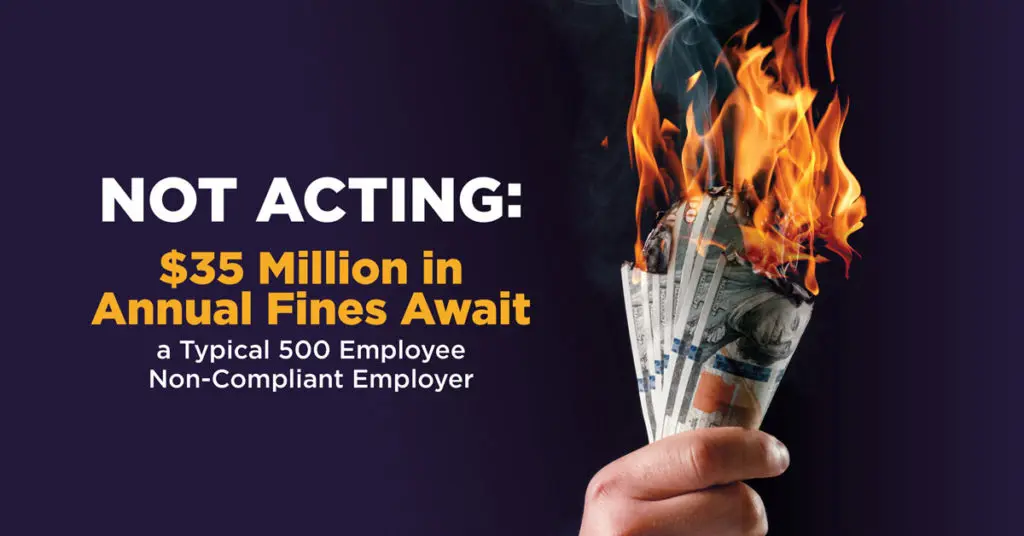
The Biden Administration Will Fine Companies of All Sizes for Not Complying with the Transparency in Coverage Rules of the Affordable Care Act
Health Plans, management consultants, TPA’s, and advisory brokers are being held accountable by employer groups to ensure compliance. Meanwhile, opportunistic vendors providing fractional solutions are underserving in this critical venture, leaving significant compliance gaps and more work in the long run perpetuating their revenue stream.
To date, the Biden Administration has been patient with companies who have not complied with the Transparency in Coverage Rule, requiring that they post machine readable files (MRFs) that disclose an enormous amount of data about how much health care providers will be paid when employees receive medical services. This includes the negotiated rates for every in-network provider and the historical payments to, and billed charges from, out-of-network providers. Later, MRFs must also include in-network negotiated rates and historical net prices for covered prescription medications, broken down by health plan or prescription issuer and by pharmacy.
This data is critically important to comparative shopping tool and analytics developers for the purpose of making negotiated prices completely transparent. Much more technology will soon be required for employees. By January 1, 2023, every employer must provide employees with an online comparison-shopping tool featuring, at a minimum, 500 shoppable services including individual estimates of out-of-pockets costs based on the employee’s individualized plan selections and status of their preventive and non-preventive medical consumption. A year later, by January 1, 2024, all other procedures, drugs, durable medical equipment, and any other item or service must also be included for shopping.
Last summer, the Biden Administration announced that it would delay fines levied against employers (plan sponsors) as long as companies were working in “good faith” toward compliance. They agreed to use selective enforcement to delay excise taxes of $100 per member, per day for non-compliance. That grace period, however, expires on July 1, 2022 for MRFs, and the Administration has shown no indication that it will further delay enforcement. But worry about more than just MRFs as the grace period for the fully required shopping experience ends just months later, on December 31, 2022, and the required holistic solution set is far more complicated than simply internet posting of computer files. In fact, at the end of this past January, the Administration made it clear that it is quite serious about beginning to levy fines.
This should be a matter of great urgency for America’s employers. A company with 300 employees could be fined well over $20,000,000 a year, for example. For a company with 1,000 employees, that number could be well over $70,000,000 per year. The risk these fines pose to employers is well beyond most other risk factors companies face.
The government is sorely in need of funds. Collecting fines, particularly after a grace period, for not complying with a rule proffered by the Department of Health and Human Services, Department of Labor, and Treasury, is a legitimate source of funds. So, the question should be asked: Why is the healthcare industry continuing to drag its feet and keep employers in the dark about the perils they could soon face?
There is nothing in the Transparency in Coverage Rule that makes an exception to fines because an employer finds compliance difficult to implement (and it doesn’t have to be). Nor, of course, is there any shelter for those who dragged their feet based on a misperception that the government wouldn’t take enforcement action.
Now is the time (the deadline having officially past, in fact), for TPAs, ASOs, carriers, and advisors to make their clients aware of the financial sword of Damocles hanging over their heads. Then, they can take the needed steps to avert financial danger. Employers must be able to post their MRFs before July 1, 2022, which won’t be possible if their trusted advisors have not educated them, let alone not provided or obtained the needed negotiated rate information for them.
Rather than simply avoiding fines (which is essential, of course), there can and should be a return on investment for employers who comply with the Transparency in Coverage Rule. Plan sponsors should insist that their shopping tools go beyond compliance by putting truly actionable information in the hands of insured individuals with a technology solution that engages and motivates employees to save health care dollars and rewards them when they do so. That kind of return on investment is something that TPAs, ASOs, carriers, and advisors can present to their clients today—by introducing them to TALON or a “powered by TALON” solution provider.
Mark Galvin
Co-Founder & CEO, TALON
